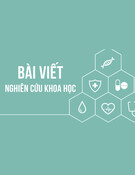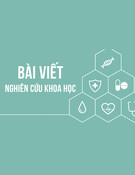H c kỳ II, 2010-2011
ọ
L ch h c: Th 4, Ti
t 4-6
ứ
ọ
ị
ế
Gi ng Viên: TS. Nguy n Th Ph ị ễ ươ
ộ ậ
ng Th o ả ả B môn CNSH Th c V t; Khoa CNSH ự Mobile:0912630268 Email: ntpthao@hua.edu.vn
ề ạ ươ ng v an toàn sinh h c ọ
Ch Ch Ch
ọ
ng 1: Đ i c ng 2: An toàn sinh h c và GMO ng 3:Phân tích khoa h c các r i ro c a sinh v t bi n đ i di ủ ế ổ ủ ọ ậ
Ch Ch Ch
ng 4: Đánh giá r i ro ng 5: Qu n lý r i ro ả ng 6: Các công c và th a thu n qu c t v an toàn sinh ủ ủ ướ ố ế ề ỏ ậ ươ ươ ươ truy nề ươ ươ ươ
h c ọ
Ch Ch
ộ ậ
i và ươ ươ ng 7:Thái đ và nh n th c c a xã h i v an toàn sinh h c ọ ộ ề ứ ủ t nam ng 8: Qu n lý an toàn sinh h c trên th gi ọ Vi ở ệ ế ớ ả
Ki n t p (d ki n): thăm ru ng kh o nghi m cây tr ng bi n đ i ế ổ ự ế ộ ồ ệ ả
ế ậ gen
Theo tài li u h
ệ ướ
ng d n phát trên l p ớ
ẫ
ậ
2 bài th o lu n: 30% ả 2 bài ki m tra 10’ : 20 % ể Thi cu i kỳ = 50% ố
Safety from exposure to Infectious Agents
Smallpox
MEDICINE: referring to organs or tissues from biological origin, or genetic therapy products, virus; levels of lab containment protocols BSL-1, 2, 3, 4 in rising order of danger
CHEMISTRY: i.e., nitrates in water, PCB levels affecting fertility
ECOLOGY: referring to imported life forms not indigenous to the region (Reggie the alligator) AGRICULTURE: reducing the risk of alien viral or transgenic genes, or prions such as BSE/"MadCow“; reducing the risk of food bacterial contamination
EXOBIOLOGY: i.e., NASA's policy for containing alien microbes that may exist on space samples - sometimes called " biosafety level 5"
Charles Baldwin at National Cancer Institute at NIH.
Symbol to be
“memorable but meaningless” so it could be learned. Blaze orange – most visible under harsh conditions
Laboratory Safety Bloodborne pathogens (BBP) Recombinant DNA (rDNA) Biological waste disposal Infectious substance and diagnostic specimen shipping
Respiratory Protection Bioterrorism and Select agents Mold and indoor air quality Occupational safety and health in the use of research
animals
Biohazards used in animal models
Viruses Bacteria Fungi Chlamydiae/Rickettsiae Prions Recombinant DNA
S l
ơ ượ ị
c l ch s v an toàn sinh h c ọ
ử ề
“If you would understand anything, observe its beginning and its development.”
1854 London cholera
epidemic
Edwin Chadwick and John
Snow
Water pollution and disease
transmission
Ignited “the sanitation
revolution”
First Laboratory Infections
1885 Typhoid (thương hàn) lab infection, unknown
cause
1893 Tetanus (uốn ván) lab infection by syringe 1894 Cholera (tả) lab infection by pipette 1897 Brucella lab infection by syringe 1898 Glanders (lở loét) lab infection by syringe 1899 Diphtheria (bạch hầu) lab infection by pipette
Germ Theory
Pasteur established the germ theory in 1862 – Demonstrated that fermentation is caused by the growth of microorganisms; published paper on lactic fermentation in 1857
Isolation and culturing of bacteria – Robert Koch: Bacillus anthracis 1877; tuberculosis bacilli 1882; Vibrio cholera 1883; Corynebacterium diphtheriae 1881 1884; Salmonella typhi – 1884 (Gaffky); Yersinia pestis 1894 (Yersin)
– David Bruce: Brucella melitensis 1887
Surveys of Laboratory Infections Surveys of Laboratory Infections
Kisskalt, K. 1915. Laboratory Infections with Typhoid Bacilli. Zeitschrift fur Hygiene and Infektionskrankheiten 80:145162 Meyer,K.F. and Eddie, B. 1941. Laboratory Infections Due to
Brucella. J. Infect. Dis. 68:2432
Sulkin, S. E. and Pike, R.M. 1951. Survey of Laboratory Acquired Infections. Amer. J. Public Health 41:769781
Pike, R.M. 1976. Laboratoryassociated Infections: Summary
and Analysis of 3921 Cases. Health Laboratory Science 13:105 114
Biosafety Concepts
Biosafety In Microbiological and Biomedical Laboratories “BMBL” (acronym)
CDC/NIH Publication Safety “Guidelines” Regulations of Institution receives NIH funding
Code of Practice and “Gold” Standard in Industry anl Gold Standard
Clinical & Research Lab. Lab. Animal Facilities
HHS Publication No. (CDC) 93-8395
http://www.cdc.gov/od/ohs/biosfty/bmbl5/bmbl5toc.htm
(1) laboratory practices needed to handle serious human and animal pathogens,
(2) possibility of creation of 'hybrid organisms' with biological activities of an unpredictable nature, and
(3) the escape of 'hybrid organisms' from the laboratory with unpredictable consequences.
Asilomar Conference on Recombinant DNA Molecules February 24 - 27, 1975
ị
h p v i h n 1
Paul Berg đã t ổ ợ
ch c h i ngh qu c t ọ ư ư ắ
ề
ữ
ơ
ứ
ọ ỹ
ị
v k thu t DNA ậ ố ế ề ỹ ổ ứ ộ 30 nhà khoa h c khác đ th o lu n tái t ể ả ậ ớ ơ t) v DNA tái t t (cũng nh ch a bi v nh ng gì đã bi ế ổ ề ế ề ữ h p và đ ra m t s nguyên t c ch đ o giúp các nhà ộ ố ỉ ạ ợ c nh ng nguy c không đáng có. Các khoa h c tránh đ ượ ọ nhà khoa h c đã đ ng ý t m d ng nghiên c u liên quan ừ ạ ồ đ n các k thu t DNA tái t h p cho đ n khi xác đ nh ế ổ ợ ế c các nguy c ti m n. đ ơ ề ẩ
ậ ượ
(i) certain experiments should be deferred,
(ii) most of the work on recombinant DNA could proceed with appropriate safety measures,
(iii) potential risks were assigned to different types of experiments, and
(iv) such safe bacteria and plasmids that could not survive in the environment if they escaped from the laboratory should be developed.
Các nguyên t c an toàn sinh h c d n đ
c n i l ng sau đó….
ọ ầ ượ ớ ỏ
ắ
The first NIH guidelines were prepared in 1975; they were
more strict than the recommendations of the Asilomar conference.
The guidelines were revised after two years; and were made much less restrictive. By 1981, most cloning experiments in E. coli K-12, certain strains of Bacillus subtilis and Saccharomyces cerevisiae were considered exempt from other requirements of NIH guidelines.
Eventually, complete exemption was granted for most recombinant DNA research. A major revision of the guidelines was effected in 1982; containment levels were lowered, and experiments that were previously prohibited, were changed to category requiring review and approval by NIH
Công
ướ ề
ạ
c v đa d ng sinh h c (Convention on ọ Biological Diversity signed at Rio de Janeiro on 5 June 1992)
Ngh đ nh th Cartagena v an toàn sinh h c (Ngh ị
ề
ọ
ị
i Montreal ngày
ị ư
ị
ọ thông qua t
ạ
ư đ nh th an toàn sinh h c) 29/1/2000

























